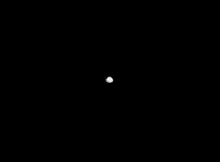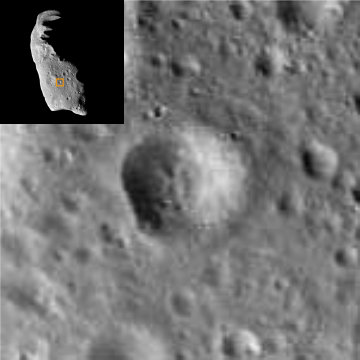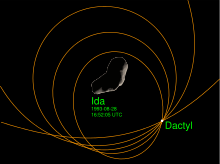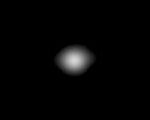
Adrastea, also known as Jupiter XV, is the second by distance, and the smallest of the four inner moons of Jupiter. It was discovered in photographs taken by Voyager 2 in 1979, making it the first natural satellite to be discovered from images taken by an interplanetary spacecraft, rather than through a telescope. It was officially named after the mythological Adrasteia, foster mother of the Greek god Zeus—the equivalent of the Roman god Jupiter.

Galileo was an American robotic space program that studied the planet Jupiter and its moons, as well as several other Solar System bodies. Named after the Italian astronomer Galileo Galilei, the Galileo spacecraft consisted of an orbiter and an entry probe. It was delivered into Earth orbit on October 18, 1989 by Space ShuttleAtlantis on the STS-34 mission, and arrived at Jupiter on December 7, 1995, after gravitational assist flybys of Venus and Earth, and became the first spacecraft to orbit Jupiter. It launched the first probe into Jupiter, directly measuring its atmosphere. Despite suffering major antenna problems, Galileo achieved the first asteroid flyby, of 951 Gaspra, and discovered the first asteroid moon, Dactyl, around 243 Ida. In 1994, Galileo observed Comet Shoemaker–Levy 9's collision with Jupiter.
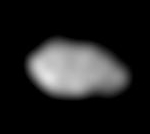
Metis, also known as Jupiter XVI, is the innermost known moon of Jupiter. It was discovered in 1979 in images taken by Voyager 1, and was named in 1983 after the first wife of Zeus, Metis. Additional observations made between early 1996 and September 2003 by the Galileo spacecraft allowed its surface to be imaged.

Vesta is one of the largest objects in the asteroid belt, with a mean diameter of 525 kilometres (326 mi). It was discovered by the German astronomer Heinrich Wilhelm Matthias Olbers on 29 March 1807 and is named after Vesta, the virgin goddess of home and hearth from Roman mythology.
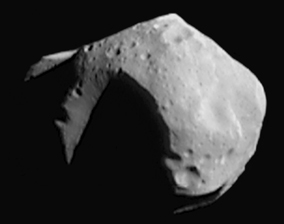
Mathilde is an asteroid in the intermediate asteroid belt, approximately 50 kilometers in diameter, that was discovered by Austrian astronomer Johann Palisa at Vienna Observatory on 12 November 1885. It has a relatively elliptical orbit that requires more than four years to circle the Sun. This tumbling asteroid has an unusually slow rate of rotation, requiring 17.4 days to complete a 360° revolution about its axis. It is a primitive C-type asteroid, which means the surface has a high proportion of carbon; giving it a dark surface that reflects only 4% of the light that falls on it.

Amalthea is a moon of Jupiter. It has the third closest orbit around Jupiter among known moons and was the fifth moon of Jupiter to be discovered, so it is also known as Jupiter V. It is also the fifth largest moon of Jupiter, after the four Galilean Moons. Edward Emerson Barnard discovered the moon on 9 September 1892 and named it after Amalthea of Greek mythology. It was the last natural satellite to be discovered by direct visual observation; all later moons were discovered by photographic or digital imaging.

Pallas is the second asteroid to have been discovered, after Ceres. Like Ceres, it is believed to have a mineral composition similar to carbonaceous chondrite meteorites, though significantly less hydrated than Ceres. It is the third-largest asteroid in the Solar System by both volume and mass, and is a likely remnant protoplanet. It is 79% the mass of Vesta and 22% the mass of Ceres, constituting an estimated 7% of the mass of the asteroid belt. Its estimated volume is equivalent to a sphere 507 to 515 kilometers in diameter, 90–95% the volume of Vesta.
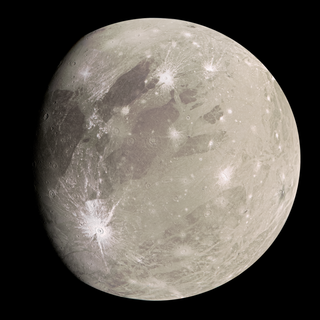
Ganymede, or Jupiter III, is the largest and most massive natural satellite of Jupiter as well as the largest in the Solar System, being a planetary-mass moon. It is the largest Solar System object without an atmosphere, despite being the only moon in the Solar System with a substantial magnetic field. Like Titan, it is larger than the planet Mercury, but has somewhat less surface gravity than Mercury, Io or the Moon due to its lower density compared to the three.
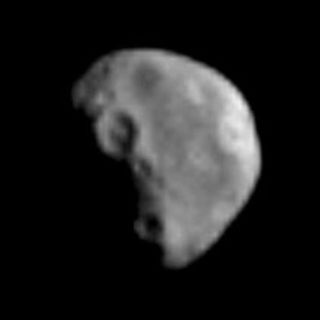
(243) Ida I Dactyl is a tiny asteroid moon that orbits asteroid 243 Ida. It was imaged by the Galileo spacecraft on August 28, 1993; Dactyl was discovered while examining the delayed image downloads from Galileo on February 17, 1994. It was provisionally designated S/1993 (243) 1. The satellite was named after the mythical creatures called dactyls who lived on Mount Ida according to Greek mythology.

Thebe, also known as Jupiter XIV, is the fourth of Jupiter's moons by distance from the planet. It was discovered by Stephen P. Synnott in images from the Voyager 1 space probe taken on March 5, 1979, while making its flyby of Jupiter. In 1983, it was officially named after the mythological nymph Thebe.
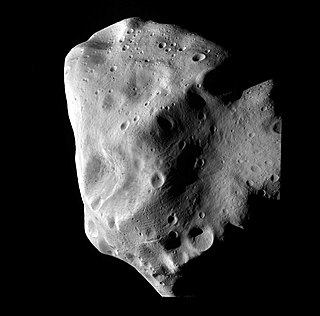
Lutetia is a large M-type asteroid in the main asteroid belt. It measures about 100 kilometers in diameter. It was discovered in 1852 by Hermann Goldschmidt, and is named after Lutetia, the Latin name of Paris.

Hebe is a large main-belt asteroid, containing around 0.5% of the mass of the belt. However, due to its apparently high bulk density, Hebe does not rank among the top twenty asteroids by volume. This high bulk density suggests an extremely solid body that has not been impacted by collisions, which is not typical of asteroids of its size – they tend to be loosely-bound rubble piles.
(45) Eugenia I Petit-Prince is the larger, outer moon of asteroid 45 Eugenia. It was discovered in 1998 by astronomers at the Canada-France-Hawaii Telescope on Mauna Kea, Hawaii. Initially, it received the provisional designation S/1998 (45) 1. Petit-Prince was the first asteroid moon to be discovered with a ground-based telescope. Previously, the only known moon of an asteroid was Dactyl, discovered by the Galileo space probe, around 243 Ida.

The Koronis or Koronian family, also known as the Lacrimosa family, is a very large asteroid family of stony asteroids, located in the outer region of the asteroid belt. They are thought to have been formed at least two billion years ago in a catastrophic collision between two larger bodies. The family is named after 158 Koronis, and the largest known member is about 41 km (25 mi) in diameter. The Koronis family travels in a cluster along the same orbit. It has 5949 members.

Space weathering is the type of weathering that occurs to any object exposed to the harsh environment of outer space. Bodies without atmospheres take on many weathering processes:

The Lac Wiyâshâkimî, also called the Clearwater Lakes in English and Allait Qasigialingat by the Inuit, are a pair of annular lakes and possible impact craters on the Canadian Shield in Quebec, Canada, near Hudson Bay.

Merton E. Davies was a pioneer of America's space program, first in earth reconnaissance and later in planetary exploration and mapping. He graduated from Stanford University in 1938 and worked for the Douglas Aircraft corporation in the 1940s. He worked as a member of RAND Corporation after it split off from Douglas in 1948 and for the remainder of his career.
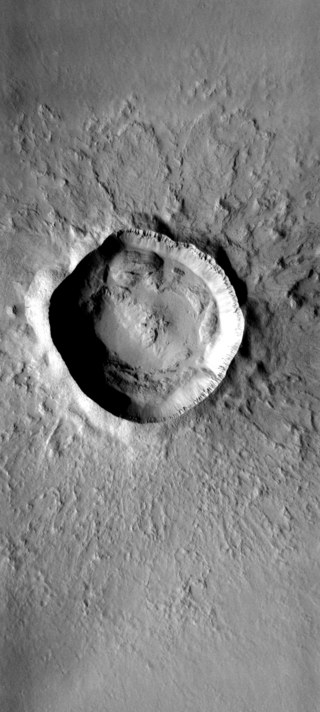
Zunil is an impact crater near the Cerberus Fossae on Mars, with a diameter of 10.26 kilometres. It is named after the town of Zunil in Guatemala. The crater is located in the Elysium quadrangle. Visible in images from the Viking 1 and Viking 2 Mars orbiters in the 1970s, Zunil was subsequently imaged at higher resolution for the first time by the Mars Global Surveyor (MGS) Mars Orbiter Camera (MOC) in 2000.
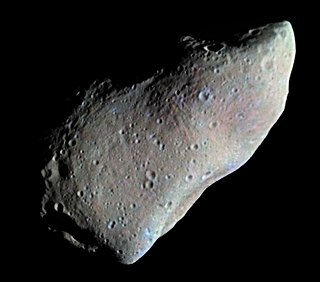
951 Gaspra is an S-type asteroid that orbits very close to the inner edge of the asteroid belt. Gaspra was discovered by Russian astronomer G. N. Neujmin in 1916. Neujmin named it after Gaspra, a Black Sea retreat that was visited by his contemporaries, such as Gorky and Tolstoy.

17246 Christophedumas (provisional designation 2000 GL74) is a stony Koronian asteroid and binary system from the outer regions of the asteroid belt, approximately 4.6 kilometers in diameter.



